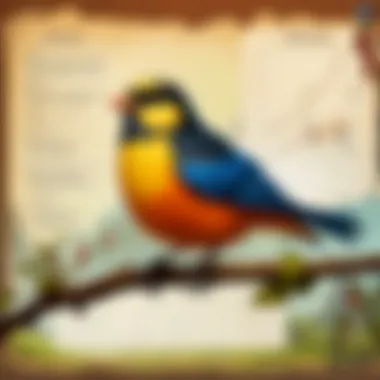Unlocking the World of Bird Training: A Comprehensive Guide for Aspiring Avian Educators


Game Updates and Patch Notes
In this section, we will examine the latest updates and patches in the world of bird training. From essential modifications to notable changes, this part offers a thorough overview of the evolving landscape of avian education. Whether it’s advancements in training methodologies or breakthroughs in behavioral conditioning, staying abreast of these updates is crucial for aspiring avian educators looking to excel in their craft.
Strategy Guides and Tips
Delve deeper into avian education with our comprehensive class strategies and training tips. Explore individualized guides focusing on different bird species, their unique learning styles, and optimal training techniques in diverse scenarios. Unlock the secrets to successful avian education, from preparing your avian companions for public performances to refining training routines for maximum efficiency.
Lore and Story Analysis
Embark on a journey through the captivating lore and narratives of bird training. Discover the rich history behind avian education, from ancient training practices to modern-day innovations. Unravel the intricacies of bird behavior and cognition as you dive into the fascinating world of avian intelligence and communication. Explore the evolving storyline of avian education, from its humble beginnings to its current status as a respected field of study.
Mod Reviews and Add-ons
Discover the must-have mods and add-ons that enhance the bird training experience. From specialized training tools to interactive learning resources, these modifications are essential for taking your avian education to the next level. Explore user-generated content that showcases innovative training methods, community-driven projects, and collaborative initiatives in the world of bird training. Follow our step-by-step installation guides to seamlessly integrate these mods into your training routine and elevate your avian education expertise.
Introduction
In the intricate realm of bird training, understanding the principles and techniques is paramount for aspiring avian educators. This article serves as a comprehensive guide, bridging the gap between theory and practical application. By delving into the nuances of avian behavior and operant conditioning, readers will gain valuable insights into the art of bird training.
Understanding Avian Behavior
Innate Behaviors in Birds
Exploring the innate behaviors of birds unveils a fascinating dimension of their nature. These behaviors, ingrained in their biological makeup, play a pivotal role in shaping their responses to stimuli. From instinctual foraging patterns to innate vocalizations, each behavior offers a glimpse into the evolutionary adaptations of avian species. Understanding and leveraging these innate behaviors are crucial for effective training strategies, as they form the foundation upon which further learning is built.
Social Dynamics in Avian Species
Avian species exhibit intricate social structures that influence their behavior in captivity and the wild. From complex hierarchies to communication rituals, social dynamics play a crucial role in shaping group cohesion and individual behavior. By unraveling the intricacies of social interactions within avian species, trainers can cultivate a deeper understanding of their feathered trainees, enhancing the efficacy of their training programs.


Principles of Operant Conditioning
Positive Reinforcement
Positive reinforcement stands as a cornerstone of effective bird training, emphasizing the rewarding of desired behaviors. By associating these behaviors with positive outcomes such as treats or praise, trainers can shape and reinforce desirable actions in birds. This principle not only motivates birds to engage in desired behaviors but also strengthens the bond between trainer and bird, fostering a positive training environment.
Negative Reinforcement
Contrary to popular belief, negative reinforcement does not entail punishment but rather the removal of aversive stimuli to encourage desired behaviors. By alleviating discomfort or removing undesirable elements when birds display desired actions, trainers can reinforce those behaviors. This nuanced approach to reinforcement offers trainers a unique tool to shape behavior without resorting to punitive measures.
Punishment Techniques
While often viewed as a last resort, punishment techniques have a place in bird training when used judiciously. By applying consequences for undesired behaviors, trainers can deter birds from engaging in such actions in the future. However, the application of punishment must be precise and contingent upon the behavior to avoid confusion or fear in birds. When administered thoughtfully, punishment techniques can aid in establishing boundaries and cultivating appropriate behavior in avian trainees.
Essential Skills for Bird Trainers
Observation and Interpretation
The ability to keenly observe and interpret avian behavior is a hallmark skill for any bird trainer. By attentively monitoring body language, vocalizations, and interactions, trainers can gain valuable insights into the emotions and needs of their feathered companions. This skill not only aids in tailoring training methods to individual birds but also fosters a deeper connection built on mutual understanding.
Effective Communication with Birds
Effective communication lies at the heart of successful bird training, transcending verbal cues to encompass body language, tone, and consistency. By cultivating a communicative environment based on trust and mutual respect, trainers can establish clear expectations and boundaries for their avian trainees. This skill nurtures a harmonious relationship between trainer and bird, paving the way for constructive training sessions and meaningful interactions.
Training Techniques
Training techniques are a fundamental aspect of the bird training process. In the intricate world of bird training, understanding and mastering the various techniques is crucial for fostering a positive learning environment and effectively communicating with avian species. These techniques serve as the foundation for establishing trust, building a strong bond, and facilitating the learning process. Bird trainers must possess a deep understanding of different training methodologies to cater to the diverse needs and behaviors of birds. By incorporating a range of techniques, trainers can address specific behaviors, enhance cognitive abilities, and nurture a harmonious relationship with their avian companions.
Target Training


Target training is a pivotal method used in bird training, emphasizing the concept of shaping behaviors through targeting. This approach involves teaching birds to touch or follow a target object, such as a stick or a designated spot. By utilizing positive reinforcement and a target as a visual cue, trainers can shape desired behaviors and facilitate communication with their feathered trainees. Target training helps birds understand commands, improve focus and concentration, and enhance coordination and physical abilities. Its versatility and simplicity make it a preferred choice for bird trainers seeking effective and humane training methods.
Shaping Behaviors through Targeting
Shaping behaviors through targeting involves breaking down complex actions into smaller steps, rewarding incremental progress towards the desired behavior. This technique allows trainers to effectively communicate their expectations to birds, encouraging them to exhibit desired behaviors gradually. By rewarding each successful approximation towards the target behavior, trainers can reinforce positive actions and gradually shape the bird's responses. Shaping behaviors through targeting promotes engagement, problem-solving skills, and a sense of accomplishment in birds, making it a highly effective training strategy.
Clicker Training
Clicker training is a highly effective conditioning method that utilizes a clicker sound as a marker to signal correct behaviors. This technique creates a clear association between a specific action and the consequent reward, enabling birds to understand and replicate desired behaviors consistently. Clicker training enhances communication between trainers and birds, facilitates quick learning, and reinforces positive behaviors. The distinctive sound of the clicker serves as a precise and instant feedback mechanism, accelerating the training process and improving overall training efficiency.
Conditioning Birds with Clicker Sound
Conditioning birds with clicker sound involves pairing the sound of a clicker with a reward to create a positive reinforcement association. When birds hear the clicker sound followed by a treat or praise, they learn to associate the sound with a positive outcome, strengthening their motivation to perform the associated behavior. Clicker training allows for precise timing in rewarding behaviors, enhances clarity in communication, and establishes a strong foundation for shaping complex behaviors. While clicker training requires consistency and proper timing, its benefits in promoting quick learning and motivation are invaluable for avian education.
Flight Training
Encouraging natural flight behaviors is essential for maintaining the physical and mental well-being of birds. Flight training focuses on enabling birds to engage in natural flight patterns, strengthening their muscles, promoting cardiovascular health, and satisfying their instinctual need for flight. By creating safe and stimulating environments for flight training, trainers can enhance birds' overall fitness, reduce stress, and improve their quality of life. Flight training not only benefits birds physically but also contributes to their mental stimulation, emotional well-being, and overall happiness.
Encouraging Natural Flight Behaviors
Encouraging natural flight behaviors involves providing birds with opportunities to fly freely in controlled environments, such as aviaries or spacious rooms. Trainers can use positive reinforcement and target training to encourage birds to fly to designated perches or locations, promoting physical activity and mental stimulation. Flight training allows birds to express their natural behaviors, build muscle strength, improve coordination, and engage in enriching activities. While flight training requires careful supervision and safety measures, its benefits in enhancing birds' physical and psychological health make it a valuable aspect of avian training programs.
Advanced Training Concepts
In this section, we delve into the critical topic of Advanced Training Concepts in the realm of bird training. Understanding the nuances of advanced training is paramount for aspiring avian educators. Advanced Training Concepts go beyond the basics, allowing trainers to delve deeper into the intricacies of avian behavior and cognitive abilities. By focusing on these advanced techniques, trainers can develop a more profound bond with their avian companions. These concepts encompass a range of sophisticated training methods that are designed to challenge both the trainer and the bird, ultimately leading to enhanced communication and mutual trust. Practicing Advanced Training Concepts elevates the training experience to a higher level of skill and understanding, paving the way for remarkable achievements in bird training.
Free Flight Training
Developing Trust and Recall


Within Free Flight Training, a core aspect that plays a pivotal role is Developing Trust and Recall. Establishing trust is the foundation of any successful bird training regimen. Through trust, a profound bond is formed between the trainer and the bird, creating an environment of cooperation and mutual respect. Developing Trust and Recall involves instilling in the bird a confidence to return to the trainer upon summoning. This trust-building exercise is essential for ensuring the bird's safety and well-being during free flight. Additionally, recall training enhances the bird's responsiveness to commands, fostering a sense of reliability and consistency in their behavior. The key characteristic of Developing Trust and Recall lies in its ability to establish a deep emotional connection between the bird and the trainer, fostering a relationship built on trust and understanding. This technique is widely regarded as a popular choice among bird trainers due to its effectiveness in creating a harmonious training dynamic. While the benefits of trust-building are manifold, it is essential to acknowledge the time and dedication required to cultivate a strong bond through Developing Trust and Recall. Patience, consistency, and positive reinforcement are vital components of this training process.
Behavior Modification
Addressing Aggression and Fear Behaviors constitutes a crucial aspect of Behavior Modification in bird training. Aggression and fear behaviors can impede the training progress and hinder the development of a positive relationship between the bird and the trainer. By addressing these behaviors effectively, trainers can create a safe and nurturing environment for the bird to thrive in. The key characteristic of Addressing Aggression and Fear Behaviors is its emphasis on corrective measures that promote positive behavioral change. Through targeted interventions and reinforcement strategies, trainers can address underlying issues that contribute to aggression and fear responses in birds. This approach is highly beneficial for fostering a sense of security and trust within the training sessions. The unique feature of Behavior Modification lies in its ability to transform challenging behaviors into positive learning opportunities, ultimately enhancing the bond between the bird and the trainer. While Behavior Modification techniques offer significant advantages in improving the overall training experience, it is essential to approach these methods with sensitivity and understanding to ensure the bird's emotional well-being and long-term progress.
Complex Trick Training
When exploring Advanced Training Concepts, delving into Complex Trick Training unveils a world of creativity and innovation in bird training. Teaching Elaborate Tricks and Performances not only entertains but also challenges both the bird and the trainer to push the boundaries of learning and communication. The key characteristic of Complex Trick Training lies in its ability to engage the bird's cognitive abilities and physical dexterity, fostering mental stimulation and physical coordination. This training technique is a beneficial choice for this article as it highlights the spectrum of capabilities that birds possess beyond basic behaviors. By teaching elaborate tricks and performances, trainers can showcase the intelligence and adaptability of avian species, creating captivating experiences for both trainers and audiences. The unique feature of this training method is its capacity to showcase the bird's potential for learning complex tasks and behaviors, underscoring the depth of their cognitive prowess. While Complex Trick Training offers numerous advantages in promoting enrichment and engagement, trainers must be mindful of the challenges involved in teaching and reinforcing intricate behaviors. Patience, creativity, and a deep understanding of the bird's cognitive abilities are essential for success in Complex Trick Training.
Challenges in Bird Training
In the realm of bird training, understanding and addressing challenges play a pivotal role in ensuring successful outcomes and the overall well-being of avian species. The ability to overcome behavioral barriers is essential for aspiring avian educators to cultivate a positive and enriching learning environment for their feathered companions. By delving into the intricacies of bird behavior, trainers can effectively navigate through various obstacles that may hinder the training process. Identifying and mitigating challenges not only fosters a strong bond between trainers and birds but also promotes a harmonious coexistence based on trust and mutual understanding.
Overcoming Behavioral Barriers
Dealing with Fearful Birds
Dealing with fearful birds is a nuanced aspect of bird training that requires patience, empathy, and a deep understanding of avian psychology. Fearful behaviors in birds can stem from various factors such as past negative experiences, inadequate socialization, or genetic predispositions. By employing gradual desensitization techniques and positive reinforcement, trainers can help fearful birds overcome their anxieties and build confidence in unfamiliar situations. The key characteristic of dealing with fearful birds lies in establishing a sense of security and trust, thereby enabling birds to gradually acclimate to new environments and stimuli. This approach proves beneficial in gaining the bird's trust and cooperation, essential foundations for successful training partnerships.
Managing Aggressive Behaviors
Managing aggressive behaviors in birds is a critical aspect of bird training that requires a strategic and compassionate approach. Aggression in birds can manifest due to a variety of reasons, including territoriality, fear, or hormonal imbalances. By implementing behavior modification techniques and providing enriching outlets for natural instincts, trainers can help birds channel their aggression effectively. The key characteristic of managing aggressive behaviors involves recognizing triggers and implementing proactive strategies to redirect negative behaviors towards positive outcomes. While challenging, addressing aggressive tendencies in birds is a pivotal step towards fostering a safe and harmonious training environment, ensuring the well-being of both the avian learners and their human counterparts.
Environmental Enrichment
Creating Stimulating and Safe Environments
Creating stimulating and safe environments for birds is fundamental to their physical and mental well-being, setting the stage for successful training experiences. Stimulating environments encompass a variety of enriching elements such as interactive toys, foraging opportunities, and diverse perching options to mimic natural habitats. Additionally, ensuring safety in the environment involves removing potential hazards, monitoring temperature and humidity levels, and offering spaces for birds to retreat and feel secure. The unique feature of creating stimulating and safe environments lies in promoting exploration, mental engagement, and physical exercise, fostering holistic development in avian companions. By prioritizing environmental enrichment, trainers enhance the quality of life for birds and create conducive settings for effective learning and behavioral growth.
Health and Nutrition Considerations
Optimizing Health through Diet and Exercise
Optimizing avian health through a balanced diet and regular exercise is paramount in ensuring the overall well-being and longevity of feathered companions. Proper nutrition tailored to specific bird species, supplemented with fresh fruits, vegetables, and adequate hydration, supports optimal physical health and immune function. Additionally, encouraging regular exercise through flight opportunities, interactive play, and environmental exploration stimulates mental acuity and physical fitness. The key characteristic of optimizing health through diet and exercise revolves around promoting a well-rounded lifestyle that meets birds' nutritional needs and exercise requirements. By incorporating these health-conscious practices into daily routines, trainers play a significant role in safeguarding birds from health issues while enhancing their vitality and behavioral wellness.





